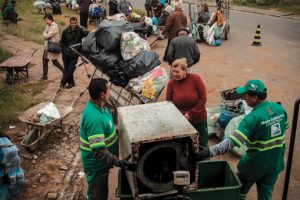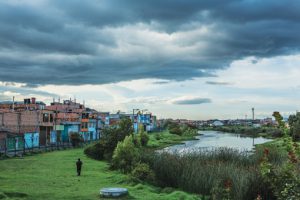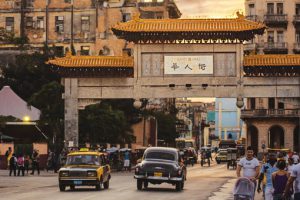
A Tale of Two Cities: Curitiba
View a slideshow of Curitiba below. It’s nine a.m. in the Nossa Senhora de Aparecida vila (shantytown) in Curitiba, Brazil, and dozens of people have formed a line at the top of a small hill. Despite a slight drizzle and the brisk cold of the morning, people stand patiently with filled wheelbarrows and carts. Two … Read more
Ask the Experts: Sustainable Cities
Sergio Fajardo Valderrama answers: Cities must trade in their paternalistic and overprotective orientation for a more independent mentality. Government helps, but citizens do not depend on it completely. We must invest in education so that citizens can be the agents of their own progress.In parallel to this, we must set in motion comprehensive social programs … Read more

A Tale of Two Cities: Bogotá
Read a sidebar on affordable housing. View a slideshow of Bogotá below. From his modest home in Ciudad Bolívar, high in the hills of Bogotá’s poor southwestern edge, Alexdy Torres, 41, can see the city of 7.5 million people spread out before him. Far to the north, he can make out the wealthy districts of … Read more

Inroads or Detours in the Drug Debate?
In June, 15 gunmen traveling in three vehicles attacked a police station in the small town of Salcaja in the northern Guatemalan highlands. By the time the shooting ended, eight policemen were dead—and one, the station’s deputy inspector, was kidnapped. The motive was initially unclear, but the government’s subsequent investigation revealed that the deputy inspector … Read more

From “Make-Sicko” back to Mexico City: The Greening of Mexico’s Distrito Federal
Read a sidebar on transportation. Mexico City has one of the world’s most complex concentrations of people. In the early sixteenth century, Mexico City already had 200,000 inhabitants, and the Valley of Mexico almost half a million—which is to say, it has always been one of the world’s largest cities. Due to its longstanding position … Read more

National to City, Diagnosis to Funding
For too long, Latin America’s urbanization has been haphazard and chaotic. As a result, the world’s most urbanized region (with over 80 percent of its population living in cities) became associated with sprawl, waste, inefficiency, pollution, and increasing vulnerability to climate change. But a new approach to this challenge emerged on the sidelines of the … Read more

Extreme Sustainable City Makeover: New York
Read sidebars on water management and citizen engagement. Most of us are familiar with the concept of the “ecological footprint.” Originally developed by Canadian academics Matthis Wackernagel and William Rees, the idea embodies a series of algorithms (numerous versions are available on the web) that convert a wide variety of consumption inputs into a single … Read more

Cuba Under Raúl Castro: Assessing the Reforms by Carmelo Mesa-Lago and Jorge Pérez-López
When Cuban President Raúl Castro first assumed power in 2006 after his bombastic brother, Fidel, fell ill, few knew what to expect. Some believed his custodianship of the presidency would be short-lived and that the island’s longtime Líder Máximo would surely come roaring back. Others simply assumed Raúl would follow in his brother’s footsteps, shepherding … Read more

Strong Constitutions: Social Cognitive Origins of the Separation of Powers by Maxwell A. Cameron
Power appears strongest when it is centralized and unified, so the idea that political power is most efficiently exercised when it is divided among different branches of government is somewhat counterintuitive. Yet, in his book on political theory, Strong Constitutions: Social-Cognitive Origins of the Separation of Powers, Maxwell Cameron argues that dividing power is a … Read more

Breves narrativas diplomáticas by Celso Amorim
Brazil featured early in the international crisis that erupted from Edward Snowden’s disclosures of U.S. access to telephone conversations of more than 30 foreign leaders over the past decade, when Rio de Janeiro-based journalist Glenn Greenwald provided information about U.S. spying in Brazil to O Globo’s television program, Fantástico. In response, President Dilma Rousseff took … Read more
From the Think Tanks
SEDEREC Mexico City has seen a surge of external and internal migration since the late 1990s. In the report, Ley y reglamento de interculturalidad, atención a migrantes y movilidad humana en el Distrito Federal: Reflexiones, SEDEREC sums up the proposals made by the public and private sectors to the Mexican government over the past 15 … Read more

Chinese New Year with Cuban Flavor
View a slideshow of Havana’s Chinatown below. Havana’s Chinatown was once the largest and most economically significant Chinese community in Latin America. In the latter part of the nineteenth century, more than 150,000 Chinese immigrants arrived in Cuba to work in the sugar fields. Their descendants opened restaurants, cafeterias, theaters, banks, and newspapers, and propelled … Read more

10 Things to Do: Valparaíso, Chile
The port of Valparaíso, nicknamed the “Jewel of the Pacific,” draws its charm from the pastel-colored houses that line its many cerros (hills) and the breathtaking vistas that await those who climb them. The city is rich in history, boasting Latin America’s oldest stock exchange, Chile’s first public library and the oldest Spanish-language newspaper still … Read more

Worst of the Worst
The U.S. holds the sad distinction of putting more people behind bars than any other country in the world—over 2.4 million people in prisons and jails. Many of the most brutal and depressing facilities—and those inside them—are tucked out of public view. A group of Connecticut film makers, however, managed to penetrate the veil of … Read more

Para todo mal, mezcal; para todo bien, también
Mezcal used to be sniffed at by Mexican sophisticates as the slightly less respectable cousin of tequila—a fiery peasant’s drink consumed in dark corner bars or rural ranchos in Oaxaca, where 94 percent of Mexico’s mezcal is produced. But that is no longer the case. For many trend-setters in the capital and elsewhere, mezcal has … Read more


